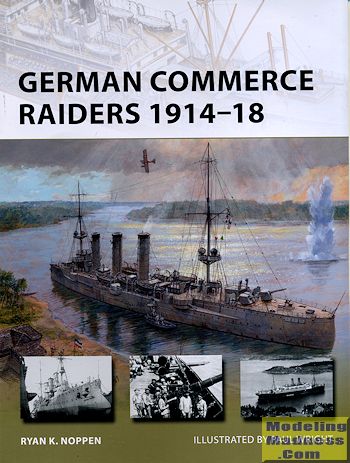 During
WWI, it was important to the Germans to try to stem the tide of supplies headed
for the British Isles. Germany was being blockaded by the Royal Navy as well so
it was important to lure away the British blockade vessels to allow for a better
flow of materiel into Germany as well. The U-boat was the best choice for this,
but this was a fairly new technology and the boats lacked range and reliability.
There also were not all that many of them.
During
WWI, it was important to the Germans to try to stem the tide of supplies headed
for the British Isles. Germany was being blockaded by the Royal Navy as well so
it was important to lure away the British blockade vessels to allow for a better
flow of materiel into Germany as well. The U-boat was the best choice for this,
but this was a fairly new technology and the boats lacked range and reliability.
There also were not all that many of them.
One of the plans was to convert German liners into surface raiders so
for that purpose, all new built liners prior to the war had reinforced decks so
they could handle the big guns. When war broke out, several of these ships were
outside Germany along with several light cruisers of the German navy. The liners
headed for areas where they could take on the needed guns while the cruisers
went into action against surface ships. In these days of coal burning ships, it
was important to maintain a small fleet of colliers. It was also common to
capture ships rather than sink them and to take prisoners if the ship was sunk.
Captured colliers were used to replenish raiders and then used with a prize
crew, to transport prisoners to a neutral port.
The cruisers were relatively successful in their job and most of these
ships racked up a decent score before being hunted down and sunk. Most of these
ships were from the German Asiatic Fleet based in China, though some were also
doing cruises in other parts of the world. The liners were not quite as
successful as they were much larger ships and consumed coal at a rather high
rate. Only about half of these ships were able to be converted as the others
were stuck in port at the start of the war.
The most successful were converted merchant ships. These ships were
innocuous looking and were generally able to pass through the blockade and were
not stopped by enemy naval vessels. While many of the liners were interred after
their raiding career, the converted merchant ships were able to make several
sorties and quite a few of them survived the war. One of them, the SMS Mowe, was
provided as a war prize to the British who converted her back to a merchant
ship. She was later bought by a German ship company and during WWII was again
used by the German Navy. She survived until the last month of the war when she
was sunk in the Baltic. Overall, the surface raider only accounted for about 5%
of the tonnage sunk during WWI, the rest going to the U-boat. However, they did
their job by taking away British ships from the blockade to hunt them down or at
least chase them.
This book covers the development of these ships and then covers the
three types of surface raider; the cruiser, the liner and the merchant ship. A
brief history of each ship is provided and thanks to period photos, we are given
the opportunity to see what these ships looked like and how successful they were
in their job. Add to this the excellent illustrations of Paul Wright and you
have a great book on a little known subject.
September 2015
For more on the complete line of Osprey books,
visit http://ospreygrp.com. In the US, it is
Osprey Direct at 44-02 23rd St, Suite 219, Long Island City, NY 11101., where you can
get a catalogue of available books.
If you would like your product reviewed fairly and
fairly quickly, please
contact
the editor or see other details in the
Note to
Contributors.
 During
WWI, it was important to the Germans to try to stem the tide of supplies headed
for the British Isles. Germany was being blockaded by the Royal Navy as well so
it was important to lure away the British blockade vessels to allow for a better
flow of materiel into Germany as well. The U-boat was the best choice for this,
but this was a fairly new technology and the boats lacked range and reliability.
There also were not all that many of them.
During
WWI, it was important to the Germans to try to stem the tide of supplies headed
for the British Isles. Germany was being blockaded by the Royal Navy as well so
it was important to lure away the British blockade vessels to allow for a better
flow of materiel into Germany as well. The U-boat was the best choice for this,
but this was a fairly new technology and the boats lacked range and reliability.
There also were not all that many of them.